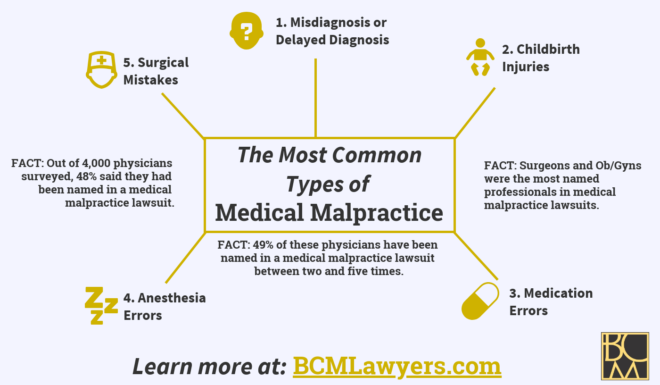The Most Common Types of Medical Malpractice
FAST FACTS
- Out of 4,000 physicians surveyed, 48% said they had been named in a medical malpractice lawsuit.
- Surgeons and Ob/Gyns were the most named professionals in medical malpractice lawsuits.
- 49% of these physicians have been named in a medical malpractice lawsuit between two and five times.
When you make an appointment with a doctor, you assume that you will be diagnosed and treated appropriately. When your physician tells you that you need surgery, you expect to be put under, have a procedure, and wake up with the issue solved, if not at least improved. Unfortunately, people don’t always have a positive experience with medical professionals.
A medical malpractice case arises when a patient is not provided with the currently accepted standard of care by a doctor, nurse or another medical professional. Mistakes are made in only a small number of cases which is good news unless it happens to you.
It would be fair to think that once a mistake is made, it wouldn’t be made again. It’s not necessarily the case. It seems that the same medical mistakes are made repeatedly, causing patients to seek remedy in a court of law. Let’s take a closer look at medical malpractice.
Elements Necessary for Medical Malpractice
It’s important to note before we talk about any mistakes that certain elements must be present for your Mobile medical malpractice attorney to move forward with a case. A mistake doesn’t always constitute malpractice.
The elements are:
- There must have been a relationship established between the medical provider and patient.
- The medical provider had a duty of care and failed to perform in accordance with that duty.
- The patient was injured or harmed and sustained damages.
- The injury was a direct result of the medical provider’s negligence or error.
The Most Common Types of Medical Malpractice

The most common types of medical malpractice are misdiagnosis, childbirth injuries, medication errors, anesthesia errors and surgical errors. It’s not to say that errors or negligence aren’t present in other situations, but the majority of medical malpractice cases center around one of these reasons.
1. Misdiagnosis or Delayed Diagnosis
You visit a doctor because you don’t feel well. You sit with the doctor, discuss your medical history and your current symptoms. The doctor hands you a diagnosis and a prescription. The troubles begin when your symptoms don’t get better and, in some cases, get worse. You may have been misdiagnosed.
Misdiagnosis is one of the most common types of medical malpractice. If you have ever searched online for what disease or condition has a headache, for example, as a symptom, you’ll have dozens of results on your hands. There are several conditions that have common symptoms and it’s not always apparent which condition you have. This is why it is so easy to receive a diagnosis that isn’t correct.
Another issue is delayed diagnosis. When you aren’t diagnosed with anything at all immediately but later diagnosed with something that should have been treated as soon as symptoms appeared, you could suffer serious harm. Remember that it is always your right to get a second opinion, even if you don’t believe you have a condition that would be considered life-threatening.
2. Childbirth Injuries
There are a number of injuries that can be caused to both mother and child when birth injuries occur. An error or negligence on the part of a medical professional may occur at any time during the birthing process or, in other cases, during the prenatal care of the mother.
A medical professional may fail to identify birth defects or misdiagnose a condition in the mother prior to the birth of the infant. There may be an error made during the birthing process itself. It doesn’t matter when the negligence occurred. If a child or mother is injured during pregnancy or labor and delivery, a medical malpractice case may arise.
3. Medication Errors
According to a decades-old study, medication errors affect about 1.5 million people every year. The prescription given may be incorrect, the medication could be inappropriate for the condition, or a drug may be given to the wrong patient.
A medication error, however, most often occurs when a patient gets too little or too much of a drug. The doctor may write the wrong dose on the prescription, a nurse may give the wrong amount or a machine like an IV pump may malfunction.
4. Anesthesia Errors
Anesthesia mistakes can be very dangerous. The slightest error by an anesthesiologist can have devastating effects on a patient. An error can occur when a patient’s full medical history is not taken, when preoperative instructions aren’t given or when too much or too little anesthesia is administered during a procedure.
5. Surgical Mistakes
Surgical mistakes are perhaps the most frightening for patients. When you are put under anesthesia for a procedure, you have no control over the situation. This can cause a great deal of anxiety and, thankfully, most people wake up and things are just fine.
In other cases, the wrong surgery is performed, nerves are severed, medical instruments are left behind and more. Surgical mistakes have the potential to be incredibly serious and sometimes fatal.
Again, it is important to remember that not every mistake made by a medical professional will lead to a medical malpractice lawsuit. When an error is remedied before it causes harm, it is rare that a medical malpractice case will be initiated. When a patient sustains harm at the hands of a medical professional, they have every right to seek a remedy for the damages they incur.





Leave a Reply
Want to join the discussion?Feel free to contribute!